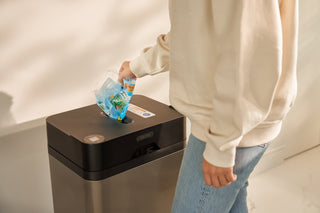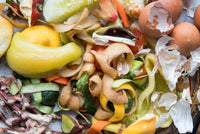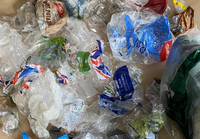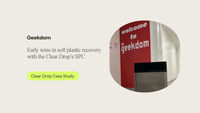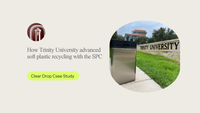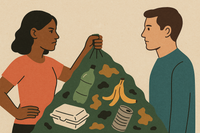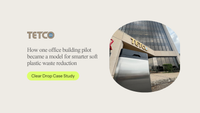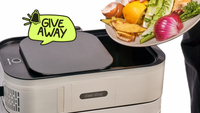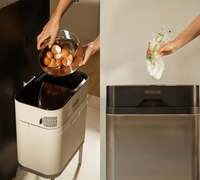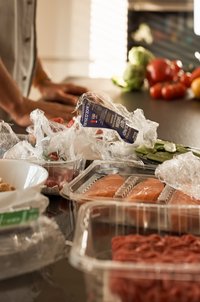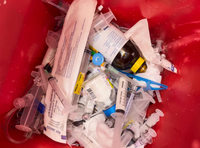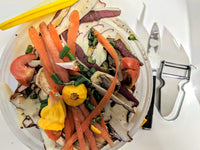Soft plastics like grocery bags, bubble wrap, and packaging film make up a growing share of U.S. household waste, yet most of them are not recyclable curbside. This guide explains why soft plastics are difficult to recycle in the United States and what practical home solutions, including a soft plastic compactor, can help reduce volume and improve recycling outcomes.
Recycling soft plastics is one of the most pressing environmental challenges today. Soft plastics – such as plastic bags, wrappers, and packaging films – are often excluded from standard curbside recycling programs. This is due to a combination of factors, including the composition of the materials, limited processing infrastructure, and consumer confusion about disposal methods.
The general reports on the plastic recycling industry in the U.S., which are now carried out by nonprofit organizations and are not systematic, don’t seem to show positive data.
According to the latest rates from research on recycled plastic, "more than 95% of the plastics generated are put in a landfill or incinerated for energy". The research groups also revealed that while plastic recycling is on the decline, "the per capita generation of plastic waste has increased by 263% since 1980".
Another investigation shows missed opportunities in about "83% of the plastic packaging that could be recycled curbside – think bottles and containers – not being put in the bin".
And what about soft plastic? It is placed on a lower priority and also shows recycling rates of less than 10 percent, still not always being calculated and reported. Soft plastic is perceived as a barrier to the efficient process of recycling other types of plastic, being put together in a blue bin for recycling.
Let’s figure out what the main challenges of soft plastic recycling are and what solutions could exist to work on changing these frustrating numbers of plastic waste and changing the attitude towards soft plastic.
What is this soft plastic exactly?
The name itself speaks about its look and structure - this film is simply soft. An easy way to identify a soft plastic product is to scrunch it up and see that it doesn’t bounce back fully.
In other words, it is any lightweight package or part of a package whose shape can be readily changed. Flexible packaging includes, but is not limited to, bags, pouches, liners and wraps that utilize plastic or film.
It can also be packaging such as grocery, zip lock, soft plastic containers, cling film, stretch wrap, shipping packaging, freezer bags, and dry-cleaning bags.
Key challenges of soft plastiс recycling
Being soft and light doesn’t mean being perfectly suitable for recycling. Recycling facilities face specific problems while having soft plastic on their board and these are the real reasons for these difficulties:
1. Contamination of recycling streams.
While being useful for packaging purposes because of its thin, stretchy, clingy structure, plastic film is still difficult to recycle without specialized equipment. If mixed with other recyclables and processed through machines, plastic packaging tangles the mechanisms and jams the machines.
This leads to operational disruptions and increased maintenance costs. Other than that, it endangers workers who try to clean it out of the equipment at the recycling facility. This problem occurs even earlier, when soft plastic is placed in the curbside recycling cart after mixed waste management.
2. Lack of recycling facilities.
Out of approximately 500 Material Recovery Facilities (MRFs) in the U.S., only 20% to 30% can handle soft plastic waste. Their limited capacity also leads to the majority of soft plastics not being processed and often ending up in landfills.
3. Multi-layered plastic materials.
Some soft plastic packaging, like aluminum-lined snack wrappers and food pouches, is often made from layers of different materials. It makes the package content protected by providing stiffness, oxygen barrier, UV protection, and sealability.
This solution complicates soft plastic recycling efforts. Separating these layers is technologically challenging, which stands for the complexity of classification, layer separation, and is economically unfeasible due to high costs for treatment.
4. Consumer confusion about plastic waste management.
Consumers are often not sure what type of plastic waste is accepted at their location because programs for recycling significantly vary. A survey revealed that "60% of people are uncertain about how and what to recycle, resulting in improper disposal of soft plastic waste".
Lack of information and awareness about the easy options for plastic recycling leads to curbside recycling full of soft plastics.
Soft plastic waste is one of the biggest environmental challenges today, leading to widespread pollution.
The key environmental risks associated with soft plastic waste are:
1. Landfill overflow

Plastic takes up to 1,000 years to decompose in landfills. During this process of degradation, plastic waste may leach potentially toxic substances into the soil and groundwater, producing environmental and health risks.
2. Microplastics
While degrading soft plastic waste fragments into microplastics, tiny parts less than 5 millimeters in size are created. These microplastics have been detected in various environments, including deep-sea sediments and remote areas, indicating their pervasive distribution. Microplastics can adsorb and transport harmful pollutants, potentially entering the food chain and posing risks to wildlife and human health. Studies have found microplastics in human organs, including the placenta, raising concerns about their impact on human health.
3. Ocean pollution
In addition to microplastics wreaking havoc on marine ecosystems, soft plastic waste can directly influence the lives of marine animals. For instance, sea turtles, seabirds, and marine mammals often mistake plastic waste for food, which leads to ingestion that can cause internal injuries, intestinal blockages, starvation, and death.

Solutions: How to improve soft plastic recycling?
The good point about these challenges is that they already have some solutions that can improve soft plastics recycling. Emerging innovations and technologies can significantly expand processing capabilities.
- Chemical plastic recycling technologies, like pyrolysis, involve breaking down plastic into smaller molecules using high heat in the absence of oxygen. Technology transforms plastic waste into raw materials such as oils, gases, and waxes, which can be used as a better alternative to virgin resource extraction.
- AI and robotics also enter the plastic recycling industry, suggesting new, efficient sorting systems. Robots are taught to identify and sort different types of plastics.
- Smart solution for your home that can make your home’s soft plastic waste management more efficient and prepare it to be actually recycled.
Clear Drop® Soft Plastic Compactor (SPC) is an example being the first home and business appliance to simplify soft plastic collection and ensure it all goes to recycling. It transforms fluffy plastic packaging into a space-saving 12×8×4-inch block. Clear Drop sends free mailing envelopes with pre-paid labels to ship compacted plastic blocks directly to the facility. Unlike grocery store drop-offs or similar products, SPC guarantees that no soft plastic is left out of the recycling chain.

How to Recycle Soft Plastics at Home
- Collect soft plastics separately from bottles and other hard plastics.
- Clean and dry them to remove food residue.
- Compact soft plastics using a home soft plastic compactor to reduce storage volume by up to 90%.
- Store compacted plastics in a bin or box until recycling.
- Take them to local retailer drop-off programs (Target, Walmart, Kroger, Whole Foods) or send them using mail-in recycling services.
Tip: Clear Drop SPC allows you to send compacted soft plastics directly to the recycling facility, avoiding the need to find a drop-off point.
Consumer responsibility still plays a significant role in the whole plastic recycling process.
- Before plastic recycling, you can think of cutting the amount of waste and reducing your soft plastic consumption. Think about changing one habit and buying some products in refillable shops instead of contributing to plastic packaging, buy from local markets with your reusable shopper bags and beeswax wraps for food.
- Reorganize your waste management - keep soft plastic waste separate from other recyclables to prevent contamination in the recycling facilities.
- Read and share with your community information about restrictions for curbside recycling programs and verify your local recycling policies to prevent contamination. Use store drop-off recycling programs with retailers like Target, Walmart, and Whole Foods. They often provide collection bins for plastic bags and certain plastic films. The How2Recycle program offers a Store Drop-Off label, guiding consumers on which plastics are eligible for these programs.
As consumers, we can play a pivotal role in reducing plastic waste by rethinking our consumption habits, organizing our home waste management, and correctly disposing of soft plastics through specialized recycling programs.
Make Soft Plastic Recycling Easier
Compact, store, and recycle from home. Clear Drop® Soft Plastic Compactor (SPC) turns bulky packaging into compact 12×8×4-inch blocks, ready for recycling.
Learn more about the Soft Plastic Compactor.
Frequently Asked Questions
Why is soft plastic not recyclable curbside in the U.S.?
Soft plastics jam sorting equipment at U.S. recycling facilities and contaminate other recyclable materials. They must be handled separately through store drop-off or mail-in programs.
Can I recycle soft plastics at home?
Yes. Collect them separately, compact them to reduce volume, and bring them to a drop-off location or use a mail-in program.
How should I store soft plastics before recycling?
Keep them clean, dry, and compacted to prevent contamination and save space.
What happens to soft plastics after recycling?
They can be recycled into composite lumber, outdoor furniture, durable packaging materials, and other long-lasting products.


